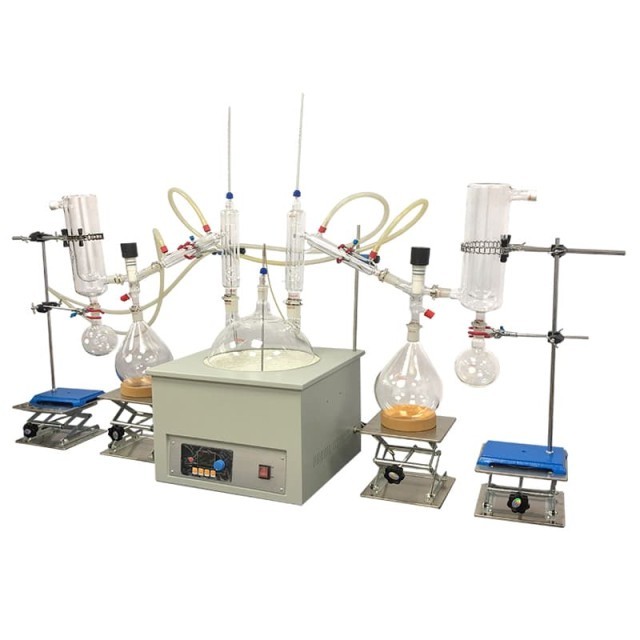About Lab Short Path Distillation
Lab Vacuum Short Path Distillation is a highly efficient and precise method of separating and purifying small amounts of compounds. The technique involves the distillate traveling a short distance, often only a few centimeters, and lab glass short path distillation is usually done at reduced pressure. This method is particularly useful for compounds that are unstable at high temperatures, as the reduced pressure allows for a lower heating temperature than would be required at standard pressure.
A classic example of a short path distillation setup would involve the distillate traveling from one glass bulb to another, without the need for a condenser separating the two chambers. This eliminates the need for a separate condenser, which can save space and reduce the overall complexity of the apparatus.
One of the main advantages of this technique is that the heating temperature can be considerably lower (at reduced pressure) than the boiling point of the liquid at standard pressure. This results in a faster and more efficient distillation process, as well as reducing the risk of damage to the compound being distilled. Additionally, the distillate only has to travel a short distance before condensing, which reduces the potential for loss of compound on the sides of the apparatus.
Operating of Short Path Distillation
This operating procedure is a set of instructions for beginners to follow in order to perform short path distillation. The instructions will guide the user through the process, but the user can adjust the details to suit their specific needs. The temperature and procedures may vary depending on the material and the experience of the operator.
- Complete a full winterization and decarbing procedure to remove any residual solvents and inactive compounds from the extracted oil.
- Place PTFE stir bar in flask and using the supplied glass funnel, begin loading material into boiling flask.
- Begin assembling all glassware and adjust stands to secure glassware. Apply a small amount of grease on each male joint and spread evenly by turning the glass in a circular motion. Place keck clips on respective joints. The receiving cow should be oriented so that the first fraction will go into the first receiving flask, not the middle receiving flask.
- Attach the heater/chiller to inlet and outlet ports on the short path. Set the temperature to 50C.
- Connect the vacuum pump to one of the 4 ports on the supplied vacuum manifold. Connect the cold trap to the receiving cow and fill the cold trap with dry ice.
- Connect the supplied gauge to the manifold and make sure all valves on the manifold are in the open position.
- Insert thermometer probe into the thermometer adapter on the head and secure the thermometer to create a tight vacuum seal. Insert the thermal probe into the adapter on the boiling flask and repeat the same process.
- Check to make sure all connections are secure and all components are in working order. Close the valve on the manifold that is open to atmosphere and begin operation.
- Turn on heat and set to 60C. Turn on stirring and set to approximately 200 RPM.
- Once the temperature reaches 50C, increase the mantle temp to 140C. Gradually increase the temperature to keep the mantle from overshooting.
- Once the mantle reaches 130C, set the temp to 220C.
- You should start to see a reaction in the head around 180-190C or slightly before. This is your first “heads” fraction. Great care should be taken to isolate this fraction and discard it.
- Continue to monitor the temperature and adjust as necessary to achieve the desired results.
- Collect the desired fractions in the receiving flasks, taking care to properly label each flask.
- Once the distillation is complete, turn off heat and stirring, and disconnect all components.
- Carefully disassemble the glassware and clean all components thoroughly.
- Store the collected fractions in properly labeled containers and store in a safe location.
- Record all relevant information such as temperatures, fractions collected, and any observations during the process in a lab notebook for future reference.
- Repeat the process with any remaining material and adjust parameters as necessary for optimal results.
Precautions
Here are some things to look out for in short path distillation:
- Safety precautions: Short path distillation requires the use of high temperatures, pressurized equipment, and chemicals, so it is important to take proper safety precautions to avoid accidents. Always wear protective gear such as goggles, lab coat, and gloves.
- Fire hazards: Distillation equipment can become very hot, so always use fire-resistant materials, and keep a fire extinguisher nearby.
- Vacuum pressure: Short path distillation is usually done at reduced pressure, so it is important to ensure that the vacuum pump is working properly and that there are no leaks in the system to avoid overpressure.
- Glassware handling: The glassware used in short path distillation can be fragile, so be careful when handling it to avoid breakage.
- Chemical compatibility: Make sure that the materials used in the distillation process are compatible with the chemicals and solvents being used to avoid chemical reactions that can damage the equipment or harm the operator.
- Proper labeling and storage: Make sure to properly label and store all materials, including the collected fractions, to avoid contamination and accidents.
- Proper disposal: Dispose of any waste materials according to local and federal regulations to protect the environment.
- Get trained: Before attempting to perform distillation, it is advisable to get proper training and familiarize yourself with the equipment and the process.
Conclusion
Short path distillation is a powerful technique for separating and purifying compounds, but it requires careful handling and proper safety precautions. It's important to take the necessary precautions to avoid accidents and protect the operator, the equipment and the environment. It's also important to get trained and familiarize yourself with the equipment and the process before attempting to perform distillation.
Related Products
Related Articles
- What Is Multiple Effect Evaporator?
- How Rotary Evaporators are Revolutionizing Distillation
- Understanding the Science Behind Short Path Distillation
- How Rotary Evaporator Can Improve the Quality of Your Distillate
- Comparing the Features of Laboratory Waterbaths: A Guide to Finding the Right Waterbath for Your Needs


